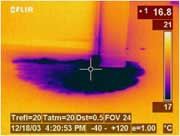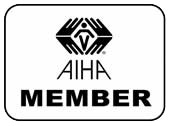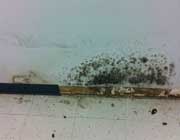Why Mold Test?
There are many valid and valuable reasons to perform mold testing. Here are 10 reasons.
Frequent Questions
Get answers to frequently asked questions about mold with our expertise.
Tool Spotlight: BCAM® Infrared Camera

One of the latest tools Mold Inspectors can use to detect mold "hot spots" in places that cannot be seen easily is the BCAM® infrared camera. This kind of equipment and technology offers the mold inspector a non-invasive means of monitoring and diagnosing the conditions of buildings - providing immediate high-resolution thermal imagery, revealing potential structural and moisture issues, energy efficiency and even rodent or pest discovery. The BCAM® infrared camera features an automatic color alarm alerts yout to moisture-laden areas during building scans which can detect potential areas of mold growth, as well as verify when structures are moisture-free during the drying out process. With the BCAM the Mold Inspector can inspect places that can't be physically reached with moisture meters. The BCAM reveals wet conditions behind surfaces such as: enameled walls and wallpaper that don't readily water stain, track leaks to their source, monitor the drying process, and confirm when a structure is dry. Indoor Air Quality (IAQ) deals with the content of interior air that could affect health and comfort of building occupants. The IAQ may be compromised by microbial contaminants (mold, bacteria), chemicals(such as carbon monoxide,radon}, allergens, or any mass or energy stressor that can induce health effects. Often it is perceived that outdoor air is polluted, but indoor air is acceptable. Scientific studies illustrate the falsity of this perception, and, in fact, indoor air is often a greater health hazard than the corresponding outdoor setting.
(240) 396-0251
E-mail: contacts@isct.com
Website:Mold Testing Washington DC
New York, NY
(917) 300-0696
E-mail: contacts@isct.com
Website:New York City Mold Testing
Miami, FL
Call:(786) 522-5546
E-mail: contacts@isct.com
Website:Mold Test Miami
Detroit, MI
(313) 483-6152
E-mail: contacts@isct.com
Website:Detroit Mold Inspection
Indianapolis, IN
(317) 220-6887
E-mail: contacts@isct.com
Website:Mold Inspection Indianapolis
Los Angeles, CA
(310) 464-3946
E-mail: contacts@isct.com
Website:Mold Testing Los Angeles
Beverly Hills, CA
(323) 210-3140
E-mail: contacts@isct.com
Website:Beverly Hills Mold Inspection
Fullerton, CA
(714) 681-1282
E-mail: contacts@isct.com
Website:Fullerton & Los Angeles Mold Inspection
Macon, GA
(478) 796-8080
E-mail: contacts@isct.com
Website:Mold Test Macon
Canton, GA
(678) 880-6897
E-mail: contacts@isct.com
Website:Mold Assessment
Marietta, GA
(678)331-7320
E-mail: contacts@isct.com
Website:Mold Inspection Marietta
Atlanta, GA
(404) 891-0250
E-mail: contacts@isct.com
Website:Mold Testing Atlanta
Boston, MA
(781) 730-0650
E-mail: contacts@isct.com
Website:Boston Mold Inspection
Glenview, IL
(708) 876-9125
E-mail: contacts@isct.com
Website:Beverly Hills Mold Inspection
Arlington Heights, IL
(847) 594-1271
E-mail: contacts@isct.com
Website:Mold Testing Chicago
Chicago, IL
(773) 770-6425
E-mail: contacts@isct.com
Website:Mold Inspection Chicage
Naperville, IL
(630) 632-5839
E-mail: contacts@isct.com
Website:Mold Inspection Naperville
Mold Certifications




Mold Pictures On Our Pinterest! Check Out The ISCT Mold Glossery While You View Our Pinterest!
Don't Let this Happen to You
